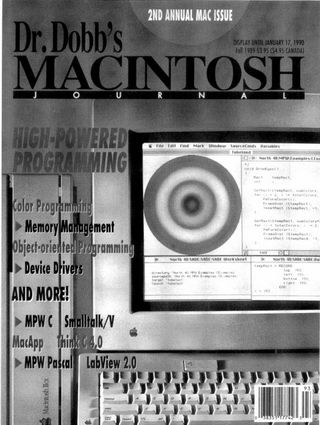
[author : JEF RASKIN] #Edito
Jef adds to the history of the Macintosh as we enter what he calls the 'mega-micro age'
TABLE OF CONTENTS
[author : CHRIS DEROSSI]
[author : JOHN ROSFORD]
The addition of features - such as Color Quickdraw - changed some of the ways Macintosk programmers program. Chris discusses some of these differences, and how new software can continue with older program.
[author : CURT BIANCHI]
Primarily known for its object-oriented tools, MacApps provides many procedural language services as well. Among these services are the kind of reliable memory management schemes required by powerful Macintosh applications.
[author : ROB DYE]
With object-oriented programming environments, such as Labview, it's possible to graphically "wire" functions together to create executable programs. Rob discusses how Labview implements OOP mecanisms, how messages are passed, how inheritance is achieved, and how objects are represented.
[author : BRYAN WATERS]
Bryan discusses the Mac's Device Manager then uses Think C 4.0's object-oriented extensions to build a device driver template.
[author : CHARLES- A. ROVIRA]
With "persistent" objects, you can write sophisticated database management systems using Smalltalk. Charles shows you what persistent objects are and how to use them.
[author : DON GASPAR]
If making backups has been slowing you down, Don's WizardCopy sector copying utility will get you back up to speed, copying 400K, 800K and 1.44Mbyte disks in 17 to 45 seconds.
[author : BRYAN WATERS]
As Bryan shows here, object-oriented tools take the pain out of developing Macintosh resources, particularly control panel devices("cdevs")
[author : JANNA CUSTER]
Once you've taken the step to become a Macintosh software developer, Apple is there with a helping hand. Janna outlines the resources Apple provides, and shows you where to find them.
